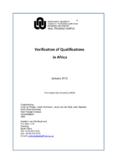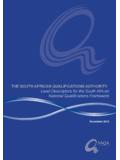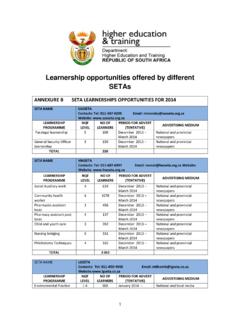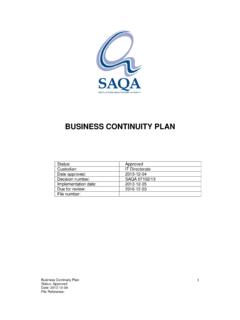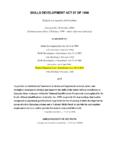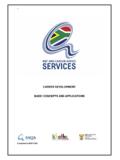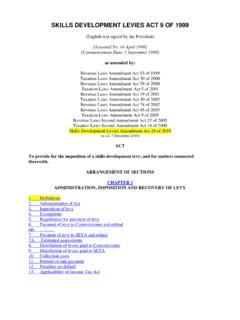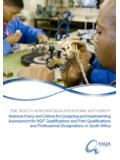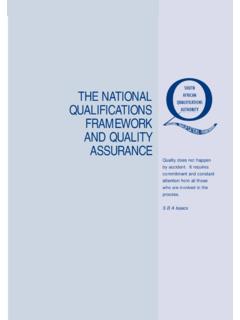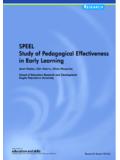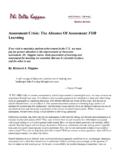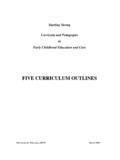Transcription of Work-integrated learning (WIL) and the HEQF
1 Work-integrated learning (WIL) and the HEQFP enelope Engel-Hills, James Garraway, Cecilia Jacobs, Terry Volbrecht and Chris WinbergNQF Research Conference: 2-4 June 2010 Overview Definitions Common misunderstandings Methodology of the position paper WIL Typology Reflections/ RecommendationsDefinitionWork- integrated learning (WIL) describes an approach to career-focused education that includes theoretical forms of learning that are appropriate for technical/ professional qualifications, problem- based learning (PBL), project based learning (PJBL) and WPL. What distinguishes WIL is the emphasis on the integrative aspects of such learning . WIL could thus be described as an educational approach that alignsacademic and workplace practices for the mutual benefit of students and mechantronics lesson, Swiss Federal Institute of Technology, misunderstandings Conflation of WIL with workplace learning ; Conflation of WIL with experiential learning ; Association of WIL with poor quality/easy is based on the principle that learning should be demonstrated to be appropriate for a qualification and should be assessed wherever it takes place or is studio, Danish Institute of Technology, Case studies- published in accredited journals.
2 - or as part of unpublished honours, masters, or doctoral work Meta-analysis/ comparisonBuilding construction students on SL (a type of PJBL) from Carl October, HDHET portfolio, 2007 1: work -directed theoretical learning Forms of knowledge ( , mathematics and physics in engineering programs) are sequenced in ways which meet both academic criteria and are applicable and relevant to the career-specific components (Barnett 2006). An example would be a subject called Mathematical Foundations of Engineering in contrast to the more traditional Mathematics I ; , directed theoretical learningType 2: problem- based learning pedagogy that encourages students to learn through the structured exploration of a research or practice- based problem (Savin-Baden & Major 2004); Students work in small, self-directed groups to define, carry out and reflect upon a task, which is usually a real-life problem (Breslow et al.)
3 2005). Inter-disciplinary; Carefully structured and sequenced problems direct the students learning towards outcomes; Lecturer as curriculum coordinator; Lecturer as resource work is associated with 3: project- based learning PJBL combines PBL and experiential learning by bringing together intellectual inquiry, real-world problems, and student engagement in relevant and meaningful work (Barron et al. 1998); Service learning is a form of PJBL that connects students with communities, service partners, and academic engineering students service learning project, 4: workplace learning Practicum (a few weeks to a few years of practical experience at a site of professional practice); Can be strongly or weakly integrated into the formal learning programme; Workplace is present, both as a learning resource and as a benchmark of practice.
4 Industrial placements, job-shadowing, interships, learnerships, learning is common in the health professions tertiary hospitals have the infrastructure to support (120)AdvancedCertificate(120)Diploma(360 )Min 60@7 Max 120@5 Bachelor sDegree(360)Min 120@7 Max 96@5 AdvancedDiploma(120) Professional Bachelor s Degree(480)Min 120@7 Min 96@8 Max 96@5 Postgraduate Diploma(120)Masters Degree(180)Min 120@9 BachelorHonoursDegree(120)Doctoral Degree(360)Min 360@105678910 PostgraduateUndergraduateWork-directed theoreticallearningProblem- based learningProject- based learningWorkplace LearningCertificate99(short, focused)2(time too short)2(time too short)Diploma99(short, focused)9(short, focused)9(short placements)Bachelor999 9(short placements)Master999(combined with PJBL)Doctor999(combined with PJBL)Issues for reflection Do all qualifications have elements of WIL or practice ?
5 Is WIL the responsibility of industry/ profession or higher education? Issues of infrastructure (case of the health sciences teaching hospital but no teaching factories .. Higher degrees in WIL useful knowledge?)
